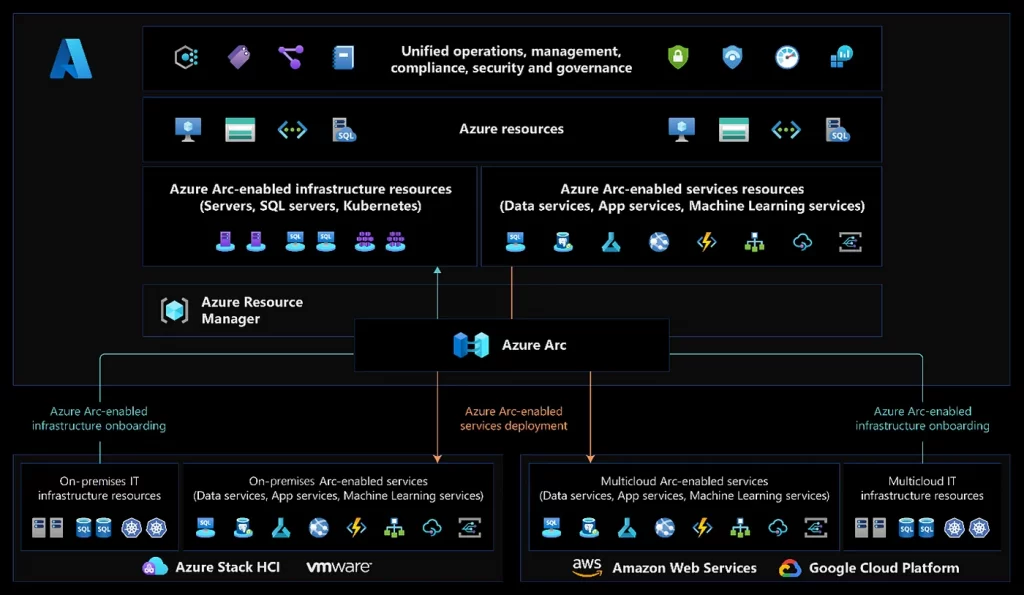By Thilaksha Kalubowila

Bridging the Gap Between On-Premises, Multi-Cloud, and Edge
A Comprehensive Overview

In the rapidly evolving landscape of IT infrastructure, organizations are increasingly adopting hybrid and multi-cloud strategies to leverage the best of both worlds — on-premises environments and cloud services. Microsoft Azure Arc emerges as a game-changing solution that extends azure management capabilities to any infrastructure, whether it’s on-premises, in multi-cloud setups, or at the edge. In this blog, we’ll delve into what Azure Arc is, its key features, benefits, and how it empowers organizations to achieve greater flexibility, consistency, and control over their IT environments.
Azure Arc is a set of technologies from Microsoft that enables organizations to manage and govern infrastructure and applications across diverse environments. It effectively extends the Azure management and security model to resources located outside of Azure, providing a unified control plane
Microsoft Azure Arc is a revolutionary service that simplifies governance and management by delivering a consistent multi cloud and on-premises management platform. It acts as a bridge that extends the Azure platform, allowing you to build applications and services with the flexibility to run across datacenters, at the edge, and in multicloud environments
Key Features of Azure Arc
Unified Management — Azure Arc allows you to manage your on-premises servers, Kubernetes clusters, and even databases from the Azure portal, providing a consistent management experience across different environments.
Kubernetes Management — With Azure Arc, you can deploy and manage Kubernetes applications across on-premises, multi-cloud, and edge environments. It supports popular Kubernetes distributions, enabling consistent deployment and operations.
Azure Services Anywhere — Azure Arc-enabled services, such as Azure SQL Managed Instance and Azure PostgreSQL Hyperscale, can run on any infrastructure, allowing you to leverage Azure’s powerful services wherever your data resides.
Governance and Security — Implement Azure policies across your hybrid environment to ensure compliance and security. Azure Arc enables you to enforce governance policies consistently across different resources and environments.
Simplified Operations — Automate routine tasks and streamline operations using Azure automation and DevOps tools. Azure Arc supports Infrastructure as Code (IaC) and GitOps, making it easier to deploy and manage resources declaratively.
Hybrid Identity: Integrate your on-premises and cloud environments with Azure Active Directory (AAD) to provide a unified identity and access management experience.
Resource Types Supported by Azure Arc
Azure Arc supports the management of various resource types hosted outside of Azure
Servers — Manage Windows and Linux physical servers and virtual machines hosted outside of Azure
Kubernetes clusters — Attach and configure Kubernetes clusters running anywhere, with multiple supported distributions
Azure data services — Run Azure data services on-premises, at the edge, and in public clouds using Kubernetes and the infrastructure of your choice.
SQL Server — Extend Azure services to SQL Server instances hosted outside of Azure.
Virtual machines — Provision, resize, delete and manage virtual machines based on VMware vSphere or Azure Stack HCI and enable VM self-service through role-based access
Getting Started with Azure Arc
1. Connect Your Infrastructure — Begin by connecting your on-premises servers, Kubernetes clusters, or databases to Azure Arc. This can be done through the Azure portal, CLI, or via automation scripts.
2. Deploy and Manage Resources — Once connected, you can deploy and manage your resources using Azure Arc. Utilize Azure Resource Manager (ARM) templates, policies, and automation tools to manage your hybrid environment.
3. Implement Governance — Apply Azure policies to your Arc-enabled resources to ensure compliance and enforce security standards across your entire IT landscape.
4. Leverage Azure Services — Explore and utilize Azure Arc-enabled services to bring the power of Azure’s PaaS offerings to your on-premises and multi-cloud environments.
Conclusion
Azure Arc represents a significant step forward in hybrid cloud management, offering a comprehensive solution for managing diverse IT environments with a unified approach. By extending Azure’s powerful management and governance capabilities beyond the Azure cloud, organizations can achieve greater flexibility, control, and efficiency in their IT operations. Whether you’re looking to streamline operations, enhance security, or leverage Azure services across different environments, Azure Arc provides the tools and capabilities to meet your needs.
With Azure Arc, the future of IT management is here bridging the gap between on-premises, multi-cloud, and edge, and empowering organizations to innovate and thrive in a hybrid world!
References: Microsoft Learn (https://learn.microsoft.com/)




